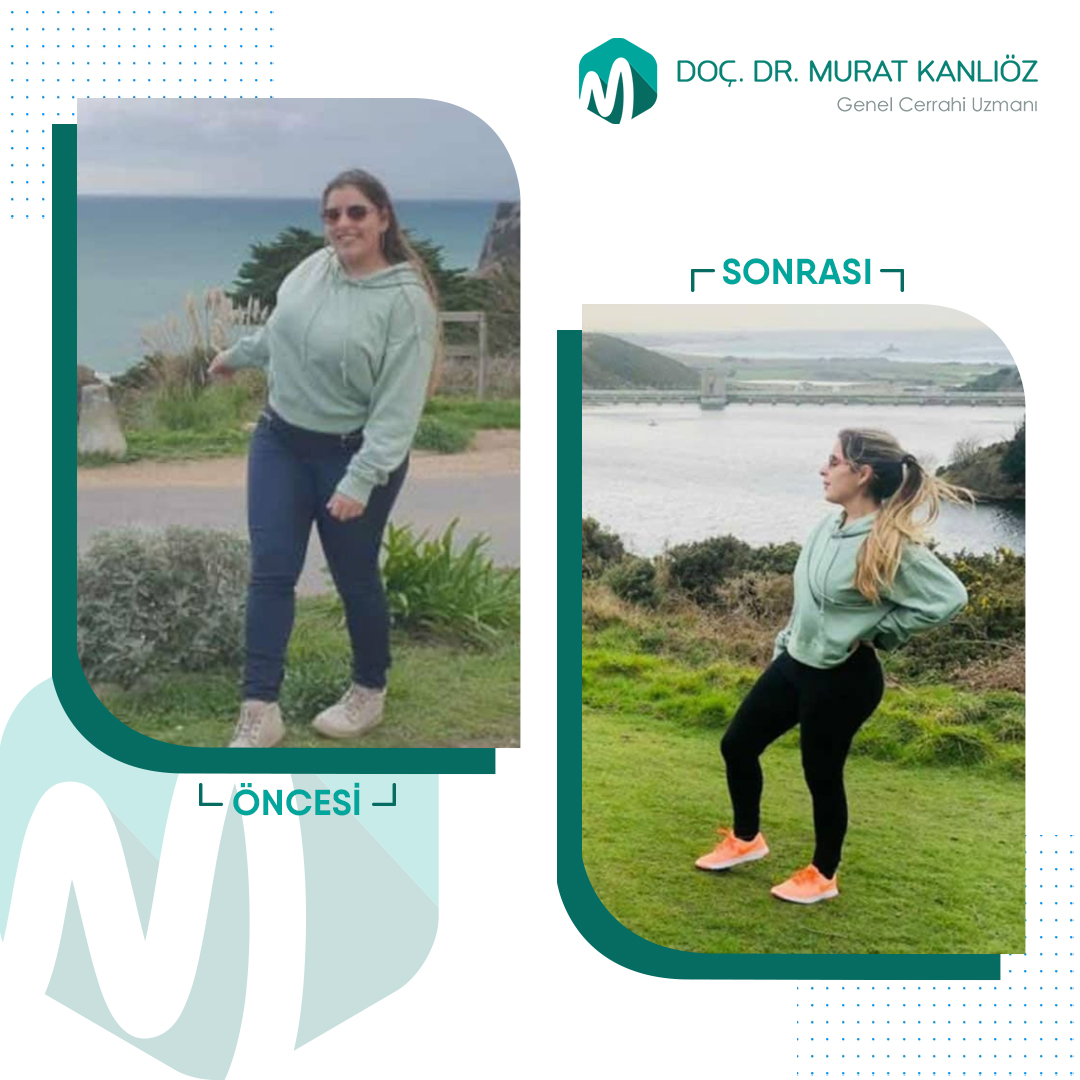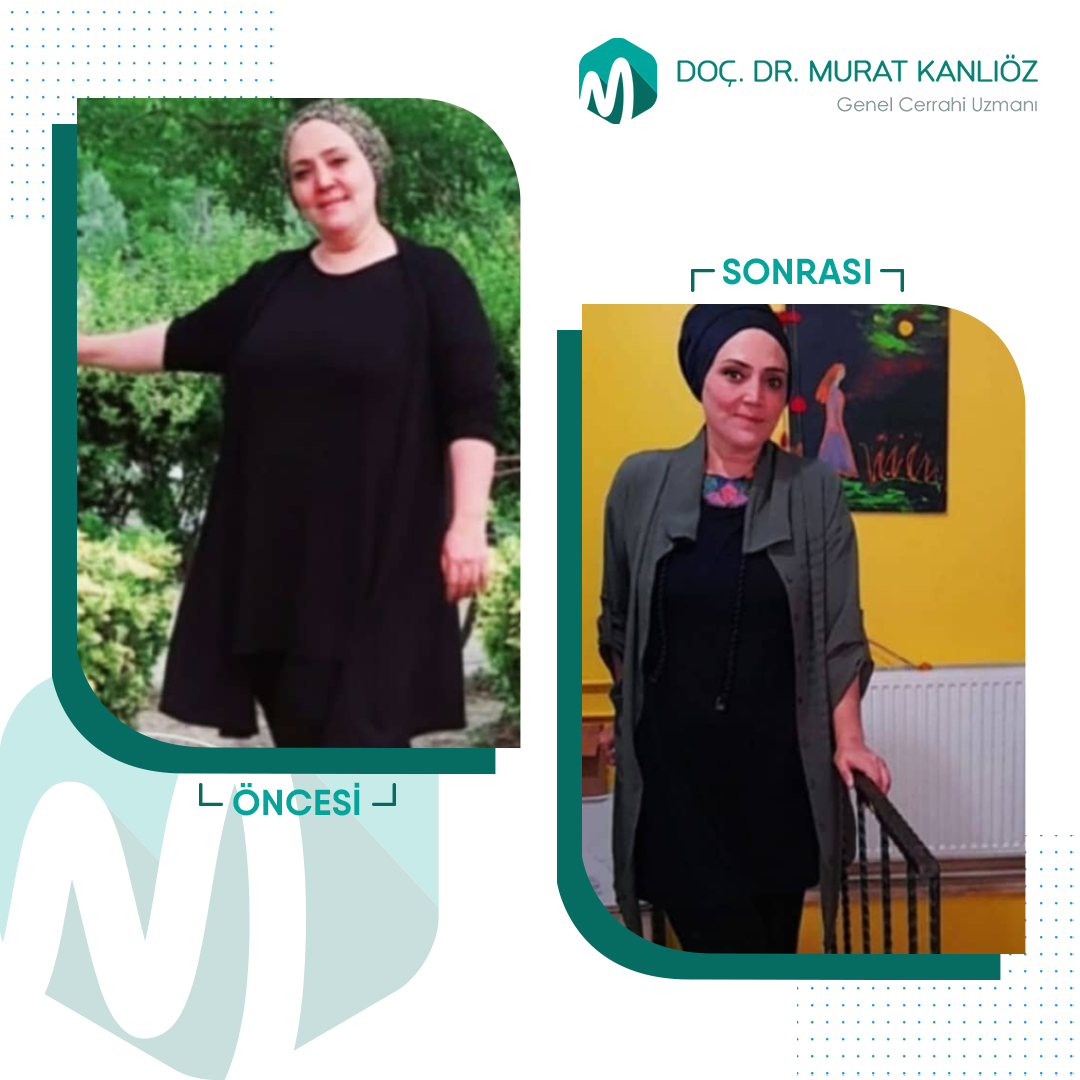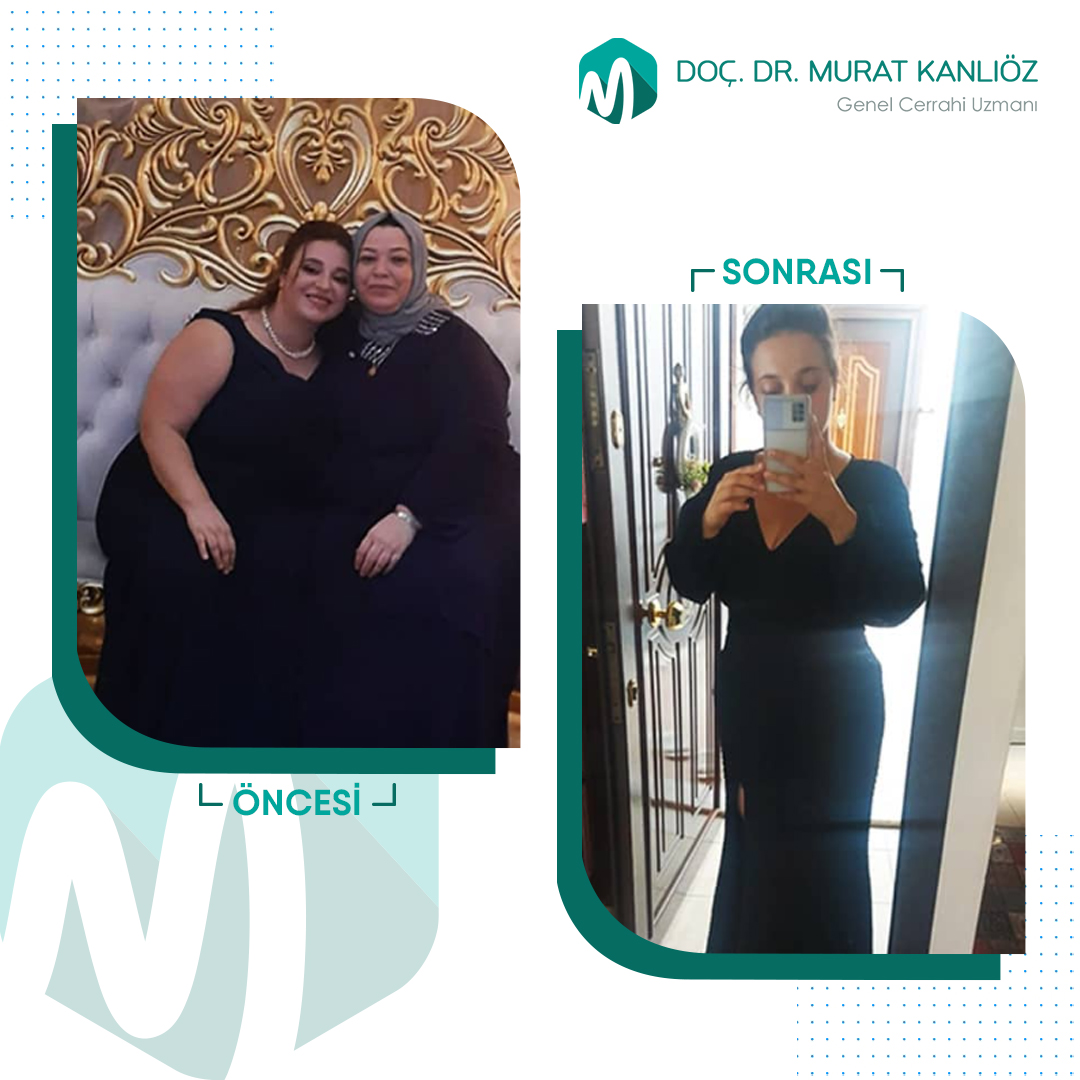
What is Transit Bipartition?
Transit Bipartition Surgery: Transit Bipartition Surgery refers to the surgical procedure used to treat patients with obesity and Type 2 Diabetes mellitus.
How is Transit Bipartition performed?
This method involves creating canals between the inside and outside of the abdomen through 5 very small incisions (about 5-15 mm in size) made in the anterior abdominal wall, using apparatus called trocars, which allow access to the abdomen. The procedure first involves inflating the abdomen by introducing CO2 (carbon dioxide) gas into the abdomen through the first inserted trocar, thereby creating a suitable field of view to perform the procedure. The procedure is performed using specially designed laparoscopic materials for grasping and pulling, opening, cutting, controlling bleeding, sealing the vessels, suturing, and excision, which are inserted into the abdomen through these canals.
First the patient undergoes modified gastric sleeve surgery (sleeve gastrectomy). Unlike the standard sleeve gastrectomy, such sleeve gastrectomy procedure involves leaving enough stomach near the gastric outlet for anastomosis (joining) with the small intestine.
- The lower left outer axis of the stomach, called “curvatura majus”, is detached from the structure called “gastrocolic ligament”, having an abundant vascular structure and to which it is connected from the beginning to the end of the stomach, by both sealing and dissecting the vascular structures, using a device known as “ligasure”, provided that the device is advanced from the stomach border. Then, a titanium-wire stapling procedure is performed in three rows, side by side, on each of the parts of the stomach that will be removed and left, starting from the lower left outer part of the stomach, leaving about the thickness of the esophagus between the esophagus and duodenum, and it is divided by cutting it in the middle with the blade system available on the stapler. Each stapler stroke staples a 5 cm area, followed by an incision. About 60-70% of the stomach is removed in about 4-5 strokes, starting from the bottom of the stomach and moving upwards, leaving a stomach “similar to a drum mallet”, provided that it narrows towards the gastric outlet. To ensure that the part of the stomach that will not be removed is the size we want, a hose-like instrument called “calibration tube”, which is inserted through the mouth into the stomach, is used as a guide.Then the small intestine (jejunum) is dissected with a stapler starting at 150 cm from the gastric outlet. The distal (next) segment of the dissected jejunum is stapled to the stomach left for anastomosis after the sleeve gastrectomy. The dissected proximal (previous) jejunal segment is stapled to the 80th cm of the distal jejunal segment using a stapler and the procedure is thus completed.The part of the stomach that is removed by the procedure is taken out of the abdomen through a 15 mm abdominal opening using grasping and pulling instruments. Then the procedure site is checked for any bleeding. If any, the bleeding is stopped. The remaining stomach is tested for leaks by administering pressurized blue serum through an oral gastric catheter. If any, the leak is sealed.Upon completion of the whole procedure, an intra-abdominal cleansing is performed. Over the line where the stomach is stapled, a silicone tube called “drain” is placed, and the tip of this tube is taken out of the abdomen through one of the openings we make in the abdominal wall for insertion of the trocar. This drain serves to drain out any post-procedure bleeding or leaking fluids, if any, and also gives us an idea about whether we need to perform an additional procedure due to leaks and bleeding. This drain is also used on the 2nd day after surgery to test for leaks by making the patient drink blue colored water through the mouth.
Finally, two of these 10-15 mm trocars are sutured using special instruments both for the possibility of hernia and for bleeding control. With the trocar valves opened, the CO2 (carbon dioxide) gas in the abdomen is completely evacuated. All trocars are pulled out and removed out of the abdominal wall. The minor incisions are sutured and the surgical procedure is thus finalized.
What is Transit Bipartition for?
The procedure aims to help weight loss as well as to treat Type 2 Diabetes mellitus.
What Mechanism does Transit Bipartition use for Weight Loss and Sugar Regulation?
The patient’s stomach volume is reduced by sleeve gastrectomy, thus preventing the patient from overeating. Also, the first 100 cm of intestine from the gastric outlet is where the majority of carbohydrates (sugar, wheat, corn, rice, fruit, etc.) are absorbed. While some of the food we eat (about 1/3) flows into the duodenum through the normal route, some (about 2/3) first contacts the intestine at 150 cm after the gastric outlet thanks to the bypass (gastrojejunostomy) performed. This ensures that 2/3 of the carbohydrates are mostly excreted in the feces without being absorbed. And this helps not only to lose weight but also to reduce the absorption of sugars contained in the food consumed.
How much weight can I lose after Transit Bipartition and when does my diabetes improve?
What is primarily aimed in Transit Bipartition is to treat Type 2 Diabetes. It serves to treat obesity as a secondary purpose. Within days after surgery, a “Blood Sugar Regulation” is achieved. However, the maximum effect is usually achieved after about one month.
Transit bipartition surgery provides weight loss for two years, if considered in periods of three months each. However, the weight loss decreases with each trimester from the beginning. The most weight loss is observed in the first three months after the procedure. The patient loses 20-25% of his/her excess weight in the first trimester, 15-20% in the second trimester, 10-15% in the third trimester, 5-10% in the fourth trimester and 5% or less in the following trimesters.
But these rates may vary depending on the patient’s diet and exercise.
Is Transit Bipartition Superior to Sleeve Gastrectomy and Gastric Bypass?
Studies show that no surgical procedures are superior to one another in terms of weight loss in the treatment of obesity. Indeed, sleeve gastrectomy is often a procedure of preference in the treatment of obesity alone, as the anatomical structure is altered by transit bipartition and gastric bypass. “Transit Bipartition” and “Gastric Bypass” are methods called metabolic surgery, which are preferred for patients with obesity and Type 2 Diabetes. Severe postprandial abdominal pain may develop in 10-15% of patients after transit bipartition and gastric bypass due to the altered anatomy that allows food to rapidly reach the advanced intestinal segments. This condition is called “DUMPING SYNDROME”. Sleeve gastrectomy does not lead to dumping syndrome. “Gastric Bypass” is a more favored method in the treatment of patients with Type 2 Diabetes and obesity compared to transit bipartition.
Who can have Transit Bipartition Surgery?
- Patients with BMI above 30 kg/m2 and concomitant Type 2 Diabetes (1)
- Those under 65 years of age
- Those over 18 years of age
Who cannot have Transit Bipartition Surgery?
- Uncontrolled schizophrenics
- Pregnant women
- Those who want to conceive in the next year
- Those with stomach tumors
- Those who receive ongoing treatment for cancer
- Those under 18 years of age
- Those over 65 years of age
- Those with comorbid health problems who cannot tolerate a surgical operation
- Alcohol and drug addicts
When is Transit Bipartition Surgery performed?
Transit Bipartition should be performed at the best possible time for patients who cannot lose weight despite following diet, exercises and undergoing endoscopic procedures for obesity, and who have a BMI above 30 kg/m2 and type 2 diabetes mellitus.
What are the risks involved in Transit Bipartition Surgery?
The most important criteria determining the risk is the level of experience of the team performing the surgery. The most significant factors posing risks include poor experience, lack of diligent work, inappropriate physical conditions due to budgetary concerns, use of low-cost materials, and inexperienced auxiliary medical personnel.
Possible risks involve:
- Leaks from anastomosis sites (1.5-2%)
- Postoperative bleeding (2-3%)
- Embolism in the lung and brain (0.5-0.8%)
- Intra-abdominal organ injury during the procedure (0.5-1%)
- Infection (3-5%)
- Risk of death (0.5-0.8%) (as with any major surgery)
- Severe postprandial abdominal pain may develop in 10-15% of patients after transit bipartition due to the altered anatomy that allows food to rapidly reach the advanced intestinal segments.
What are the instructions I should follow after Transit Bipartition Surgery?
- The patient should change his/her eating habits and follow the recommendations
- Eating a large meal quickly at once leads to a feeling of fullness and vomiting
- The foods in the carbohydrate group (flour, sugar, fruit, rice, etc.) and sugary, carbonated drinks should be avoided
- It is recommended to swim or walk briskly for at least 30 minutes a day
- Heavy sports should be avoided in the early period
- Sedentary life should be avoided
Please contact us for further information about endoscopic treatments for obesity and transit bipartition surgery prices.
References:
- Eisenberg, D., Shikora, S.A., Aarts, E. et al. 2022 American Society of Metabolic and Bariatric Surgery (ASMBS) and International Federation for the Surgery of Obesity and Metabolic Disorders (IFSO) Indications for Metabolic and Bariatric Surgery. OBES SURG 33, 3–14 (2023). https://doi.org/10.1007/s11695-022-06332-1
Please contact us to get more detailed information about endoscopic treatments and flora transplantation for obesity. You can reach us via E-mail or Whatsapp.
Before & After





Frequently Asked Questions (FAQs)
The procedure takes 120 minutes on average.
The patient is preferably hospitalized the day before the procedure to complete the necessary tests and examinations, or the pre-procedure tests and examinations are performed on an outpatient basis and the patient is hospitalized on the day of surgery. The patient is hospitalized on the day of surgery and for two days afterwards.
The patient is tested for leaks by drinking blue water two days after the surgery. Unless the blue water is flowing through the drain inserted in the abdomen, nutrition is started by switching to liquid diet, starting with water. During this period, you should eat small portions at frequent intervals and chew and swallow the food thoroughly. You should avoid carbohydrate foods and carbonated drinks.
Four hours after the surgery, the patient is allowed to stand up and start walking. The patient can also relieve himself/herself.
On the third day after surgery, provided that there is no flow from the drain inserted into the abdomen and the patient’s nutrition and vital signs are normal, the drain is removed, and the patient is discharged with a prescribed diet and medication.
The last follow-up examination is performed three days after discharge. The patient is then invited for a follow-up visit if he/she lives in the city where the clinic is located. If the patient lives in another city or country, he/she is given a calendar of check-up periods. If necessary, he/she is followed up at 3 and 6 months after surgery at his/her place of residence. However, for monitoring the rate of weight loss and blood sugar, our dietitian contacts the patient once a month for the first six months and once every 3 months for the next 18 months.
You can resume your social life gradually from the 10th day after the surgery.
You can gradually start doing housework after 15-20 days.
You can start to take care of your personal needs and self-care after 15-20 days.
You can start taking care of your children after 20-25 days.
This depends on your job. If you are working in an office job that is not very tiring, you can start working on the 10th day after the surgery with a half-day shift for the first week. However, you need to wait 30 days for labor-intensive jobs requiring mobility. If you hold a job in the heavy and dangerous group, you should return to work after 45 days.
You are allowed to travel short distances (50-100 km) as soon as you are discharged. You can travel for more than one hour (bus, car, plane) one week after surgery, 3-6 hours 2 weeks after surgery, and longer distances at least 3 weeks after surgery. When traveling long distances, it is important to stand up and walk for a few minutes every 30 minutes.
You can start with 15-minute walks on day 10 and gradually increase the physical activity. You can start swimming one month after surgery. You can start exercising with equipment after 45 days.
It is recommended not to conceive, preferably within the first year after surgery. A pregnancy after reaching a healthy weight will go more smoothly.
It is recommended to avoid sexual activity in the first month after surgery.
